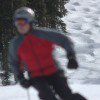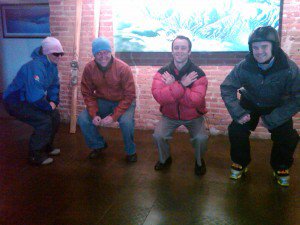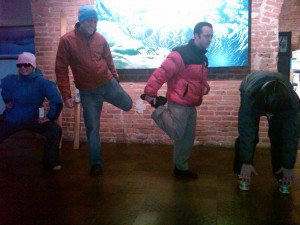It’s funny to see what motivates people
to exercise. In my experience, it’s varied from wanting to keep off the
freshman 15 to wanting to keep up with my kids. But for many of us, a sure fire
way to kick start an exercise regime is the pending ski season.
Recall the thigh burning feeling of
your last attempt to tame Winter
Park/Mary Jane’s bumps, or the aching leg syndrome that came with sliding
down Telluride’s
steeps, or the sucking wind sensation that accompanied the hike to Crested
Butte’s extremes – there’s motivation for you.

StartFragment
Over the summer, ski legs
can turn to mush as fast as a home made hot air balloon. With two resorts
open in Colorado, there is no better time like the present to get in ski
season shape. For some tips on where to start, we asked our resident ski
technique guru, and Colorado Ski
Country USA’s 2009 Ski Instructor of the Year
StartFragmentfrom Winter
Park, Julie Pierce

StartFragment
In the two years that Pierce has been
employed as a full time instructor at Winter
Park Resort, she achieved her PSIA (Professional Ski Instructors of
America) Level 3 Certification and Trainers Accreditation in alpine skiing. She
also has her AASI (American Association Snowboard Instructors) Level 1 Certification
in Snowboarding.
Julie had a very successful Jr.
USSA/FIS Ski Racing Career for 10 years prior to coaching, placing in the top
five in the Junior Olympics many times. As a result of her experience ski
racing successfully at such a high level, Julie has many well-developed skills
that she translates into her career as an instructor and trainer.
StartFragment
CSCUSA:
What type of physical preparation should people be doing to get ready for ski
season?
JP: A lot of people forget
about core strength. They lift weights to strengthen their legs and upper
bodies and neglect their core. Having a strong core really pays off during ski
season. You need a strong center when you skiEndFragment
StartFragment
I can’t squat as much as some strong
guys, but I can hold a turn as well as they can because I have a strong core.
CSCUSA:
What types of exercises can people do to strengthen their cores?
JP:
There are lots of exercises that people can do. If you do a lot of exercises
without good form, you’ll get hurt, so I would say that, in any exercise, people
should focus on a proper form.
‘Planks’ is a good exercise for the
core. To do this exercise, you balance on your elbows and toes and stabilize
your body above the ground. This one is good for many ability levels because
you can strengthen yourself by balancing on your knees first and then move on
to stabilizing yourself on your toes as you get stronger.
EndFragment

Planks (Kind of) by the CSCUSA staff
StartFragment
It’s easier to maintain good form in
doing an exercise such as planks vs. doing sit-ups. It’s certainly easier for
me to keep up my form with planks.
People also forget about strengthening
their backs. Doing exercises such as ’supermans’, where people lie on their
front and raise their arms and legs above the ground, are great to work on
overall back strength.
People who go skiing with weak backs
tend to compensate by relying too much on their hamstrings and leg muscles. The
best option is for people is to use their core strength, but in addition to
that, leg training in quads and hamstrings together could help to prevent knee
injuries.
CSCUSA:
Are there any good quad and hamstring exercises that you would recommend?
JP: Squats are good to do,
but you need to make sure that, if you do squats, that you do something
specific for your hamstrings too, in order to balance out the strengthening.
This will help to stabilize your knee too.EndFragment

Squats (Sort of)
StartFragment
CSCUSA:
Are there any exercises that people should do closer to the season vs. farther
out?
JP:
Closer to the season people should add fast-twitch aerobic exercises to their
workouts. (Fast-twitch means muscles that help you with short bursts of
energy.) Skiing is quick and then you get on the chair. Going hard with aerobic
exercises is good, and then rest. That is more like how skiing really is—short
bursts of a lot of energy.
The week before going skiing should be
a lighter week. Otherwise, you may get too tired while skiing because your body
is worn down from your workouts.
CSCUSA:
What about flexibility?
JP:
Flexibility is really important. When people get tight, that’s bad. People
underestimate stretching before skiing. Stretching is not just something you
should do in the gym, you should do it before you ski every time.
I’ve also found that people don’t like
to warm up before skiing. Even if you’re cold, it’s good to walk around in ski
boots to warm up. I recently saw a study of a ski school in Japan that showed
that stretching before skiing helped to prevent injuries on the mountain. There
really should be an emphasis on warming up in the morning.

Stretching
StartFragment
CSCUSA:
Are there certain foods people should be eating as they get ready for skiing or
during the day when they’re skiing?
JP: People should drink lots
of water when they go skiing. Even though people may want to eat differently
than they normally do when they’re on a vacation, they should drink a lot of
water no matter what.EndFragment
EndFragment

Drinking Water
StartFragment
Eating plenty of carbs is important
too. When it gets cold, your body needs to burn carbs to stay warm. Your body
doesn’t digest heavy foods as fast, which can work to your advantage. Combine
fast and slow digesting foods so you have energy when you need it. Having a
good base of health and exercise of course helps too.
A lot of people only come for vacation
for a week, but it takes a week or two to get in shape for that week. Being a
little sore after skiing is normal, but without prior training, you’ll be a lot
more sore than you should be.
CSCUSA:
Should first-time skiers take a lesson? What about people who have been skiing
for a while?
JP:
You can’t ski in a gym! Beginners should definitely take a lesson. They will
have a more successful day and be less tired. The instructor will teach how to
stand up when you ski and move in a way that will make you less tense at the
end of the day.
Advanced skiers sometimes
get bad form ingrained and can use a lesson to help correct that and save their
bodies in the long run. Even an hour or two can help an advanced skier quite a
lot. Sometimes a long-time skier will see one new thing in a lesson that can
really help them for a whole season.EndFragment
StartFragment
EndFragment
EndFragment
EndFragment

Comments